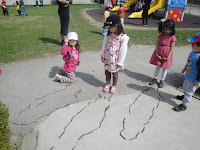 |
| Children find joy in the simplest of things! |
As I meandered through the cobble stone streets and Piazzas of Reggio Emilia, I asked myself the same question that I had been asking since I first discovered this unique pedagogy. Can we bring it home and give it meaning in our own context?
This was my second visit to the schools of Reggio Emilia and once again I was amazed by the environments, the richness of the materials, the intriguing displays, the quality of the documentation, and the interactions between teachers, children, colleagues and the community.
On my first visit I walked around dumb struck, trying to understand how such a rich pedagogy could exist. However, this time, since the initial awe factor had dissipated, I attended with purpose. I wanted to see the Loris Malaguzzi Centre; a place designed to house the exhibit, the home of the light atelier, a place where teachers from around the world meet and the first school which embodies both preschoolers and the early grades of elementary school.
When our study group entered the Loris Malaguzzi centre, I watched the faces of the attendees. For most everyone this was a first encounter with Reggio in Italy so I was not surprised to see pens move frantically across notes pads; perhaps they were hoping to remember enough to take it home and use some of what they saw. Certainly that was how I was on my first visit.
I've learned, over the last fifteen years, that you really can't bring Reggio home. But you can learn from it and let it enrich your own context. As I visit schools in both Ontario and abroad I see that no two contexts work in the same way. Environments, documentation, interpretation, it all differs because we all differ. And that's okay! It is the richness of this diversity that propels our work as teachers.
One thing I know for certain, children all over the world, live with their hearts, souls and minds connected to the universe. They find joy in the simplest of things. Children in Italy chase pigeons in the Piazzas. Children in Canada feel the wind blow through their hair as they swish across an ice rink. Children of Mexico run in the sand and feel the marvelous crash of the ocean waves on their toes.
The question then to ask is what do we feel as adults? What are our intentions and why have we chosen to spend our lives enriching the contexts of education for children? When you find your answer, then you too will have found a small part of Reggio because, in my opinion, the heart of this pedagogy lies in the deep commitment to giving value to the child and the culture of childhood.
And so to honour the deep commitment of all my teachers, I share the entries in this blog with all of you so that we may all grow as a community of teachers supporting the children of the world.
A blessing on you all for your tireless work and for visiting this site. It has been my extreme honour to dialogue with teachers from around the world. I look forward to our continuing exchange of ideas.
It is all for the children of the world!









